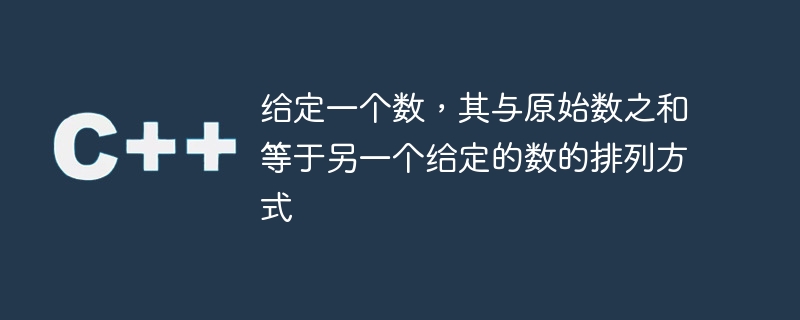

In this article, we will delve into a fascinating question involving numbers and permutations: "The sum of a number and an original number equals the permutation of another given number." This problem uniquely combines number theory and combinatorics, making it a fascinating challenge.
To clarify, given an original number and a target number, we need to find a permutation of the original number such that when we add the original number and its permutation, we get the target number.
Essentially, this question combines the concepts of number permutations, summation, and equality checking. The challenge is to find the correct permutation (or rearrangement of numbers) that satisfies the conditions provided.
The algorithm to solve this problem is as follows −
Count the frequency of each number in the original number and the target number.
Compare frequencies. If they match, it means there is a valid permutation. If they don't match, there is no valid permutation.
Here is a C solution using the above algorithm -
#include<bits/stdc++.h>
using namespace std;
bool isPermutation(int original, int target) {
vector<int> countOriginal(10, 0), countTarget(10, 0);
while (original > 0) {
countOriginal[original % 10]++;
original /= 10;
}
while (target > 0) {
countTarget[target % 10]++;
target /= 10;
}
for (int i = 0; i < 10; i++) {
if (countOriginal[i] != countTarget[i]) {
return false;
}
}
return true;
}
int main() {
int original = 1234;
int target = 2468;
if (isPermutation(original, target - original)) {
cout << "Yes, there is a permutation of the original number that satisfies the condition." << endl;
} else {
cout << "No, there is no permutation of the original number that satisfies the condition." << endl;
}
return 0;
}
Yes, there is a permutation of the original number that satisfies the condition.
In the isPermutation function, we first initialize the two vectors countOriginal and countTarget to calculate the frequency of numbers in the original number and the target number respectively. We then iterate through each number in the original number and the target number and increment the corresponding count. Finally, we compare counts. If they match, we return true; otherwise, we return false.
The main function sets the original number and the target number, and checks whether there is a valid permutation of the original number that satisfies the condition.
Let's set the original number to 1234 and the target number to 2468. The difference between the target number and the original number is 1234. Therefore, we need to check if there is a permutation equal to 1234 itself. Obviously, the original number is a permutation of itself, so the output will be "Yes, there is a permutation of the original number that satisfies the condition."
The time complexity of this algorithm is O(n), where n is the number of digits in the given number. This is because we are going through every digit in both the original number and the target number.
The space complexity is O(1) because the size of the vectors countOriginal and countTarget is constant (10), regardless of the input size.
In this article, we explore an interesting problem that blends the concepts of permutations, addition, and numerical equality. We implemented a C solution that exploits the frequency of digits in the original number and the target number.
This problem provides a unique challenge and a great way for you to practice your problem-solving skills, especially in number theory and combinatorics.
The above is the detailed content of Given a number, the sum of its sum and the original number is equal to another given arrangement of numbers.. For more information, please follow other related articles on the PHP Chinese website!




